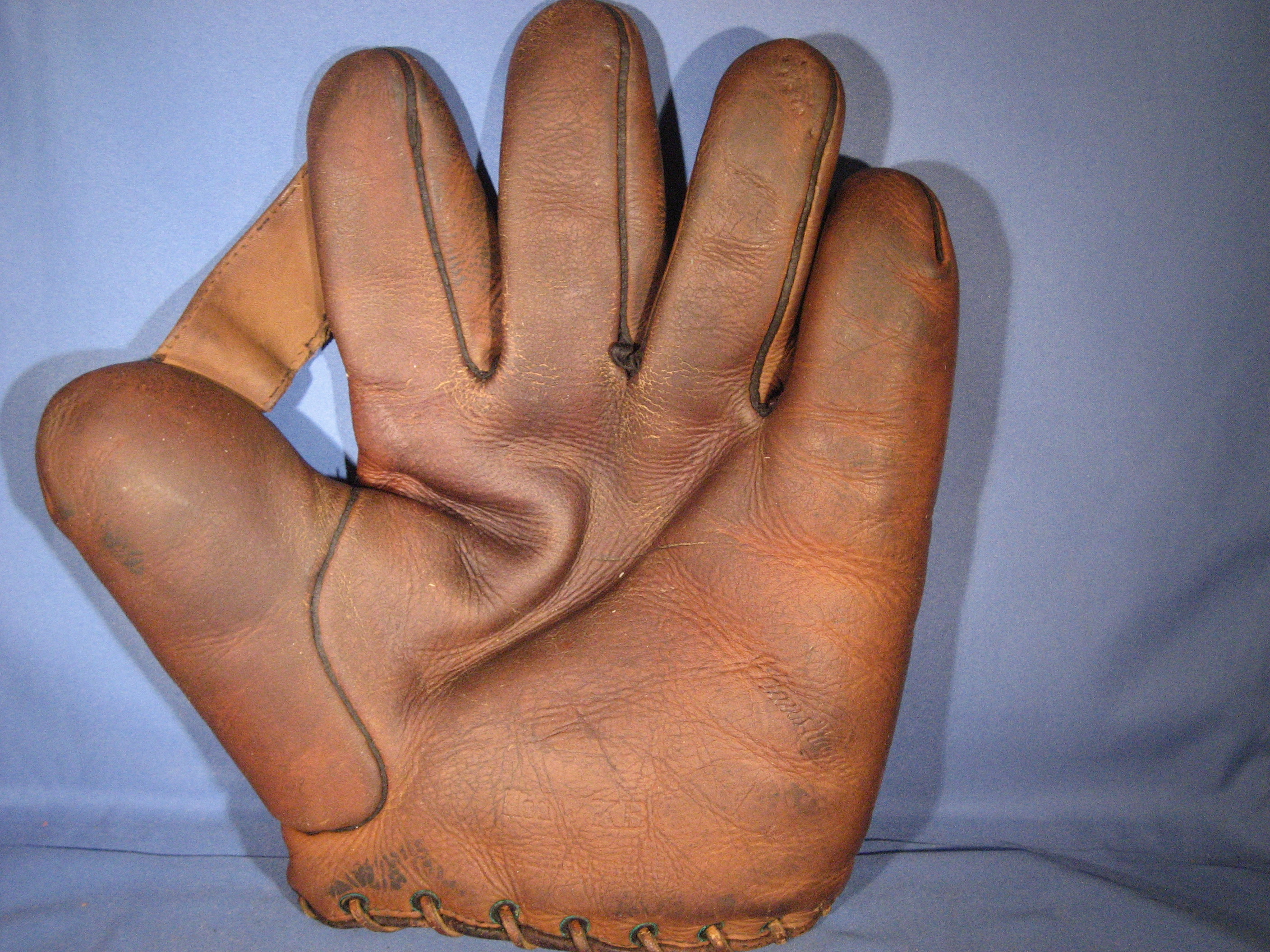How has baseball come to this? Has it always been more advantageous to do boring things?
To a degree, I think that things like walks and less risky base-running have been undervalued for much of baseball history. Only recently, statisticians have analyzed the game, and provided the hard evidence for superior strategies that Moneyball made famous. Knowledge is power, and there is no turning back once knowledge has been acquired. So, baseball is where it is at this point, for better and for worse.
That's not the whole story though. Or, at least, I think there is more to the story. There is a reason this post is called the .400 solution.
There is an equipment change that I think could be made that both would not be revolutionary, and also alter strategy more in favor of contact. Major League Baseball needs to give some critical thought to baseball mitts.
The evolution of defense is rarely discussed, even though it is striking. Take a look at some of these mitts. Vintage images are from Baseball Glove Collector.com:
One of Honus Wagner's mitts, Hall of Fame shortstop that played from 1897-1917
One of Mickey Mantle's mitts, Hall of Fame outfielder that played from 1951-1968
A modern Rawlings baseball mitt
The evolution is obvious. Fielding, way back in the late 1800s, was typically a bare-handed affair. It's pretty easy to see that mitts started as glorified mittens, and have progressively developed deeper pockets between the thumb and index finger. They have also becoming much larger in general. The Rawling's glove above could probably completely swallow both Mantle's and Wagner's mitts. In addition, the basic fundamentals of a proper catch with a modern mitt (get it in the pocket) would be lucky to work with Honus Wagner's glove.
With constantly improving equipment, it seems safe to assume that defenders have become more sure-handed. Data backs that up. Here is a chart of MLB fielding percentages, by year, from 1901 (birth of the American League), through 2011:
Again, there is an unmistakable trend - defense is getting cleaner and cleaner. Granted, errors are rather subjective, so perhaps some of the variation is due to "inflation" in scoring decisions (a natural de-emphasis on errors). Potentially supporting that possibility is a fact already discussed earlier - BABIP has generally increased the past 70 years. However, it's hard for me to look at how fielding percentages have changed, along with how mitts have changed, and think the two aren't connected.
Using the least squares method, there is a 0.8 correlation between runs scored and BABIP. Going a step further, also using the least squares method, that suggests that 64% of the variation in runs scored is explained by BABIP. Intuitively, this makes very good sense - the data suggests that when more balls in play fall in, a team scores more runs.
In recent years, people have noticed that offense across the league has sunk considerably, and most point to the drop in home runs, which is usually attributed to the drop in steroid use. However, along with a drop in home runs, BABIP has also dropped notably in recent years. Using the same method I used to study BABIP suggests that home runs explain 16% of offensive variation. Arguably, BABIP has four times the impact on offense that home runs do. The rise in defensive efficiency the past few years does not get the credit it deserves for sinking offensive numbers.
I would like to see Major League Baseball impose new requirements on baseball mitts. I'd like to see what would happen if they shrunk, and didn't have quite as deep of pockets. Smaller mitts should make fielding more difficult, meaning a few more balls should fall in. It only takes 1 more ball out of 100 in play to jump a .290 BABIP up to .300. That's a small difference that goes a long way.
Hopefully, if hitters knew that fielding is more difficult, they would try to make contact more often. There would be more of an incentive to make contact. That would help make games a little more exciting to watch.
On the flip side, pitchers might pitch for strikeouts more often if they know their defense can't help them out as much. That might lead to more walks and heavier bullpen use, which would make games worse to watch.
Perhaps no change is needed at all. Baseball naturally ebbs and flows. The way to keep a defense from shifting into bizarre configurations is by hitting to all fields. "Pure" hitters will likely become a more desired commodity as defenses ruthlessly punish hitters with optimal positioning. Pitchers and defenses have learned how to turn uppercut strokes against hitters. At some point, hitters will find ways to turn today's cutting-edge advantages into weaknesses.
However, knowledge is power, and there is no turning back from what we know about how to play the game most efficiently at this point. Pitchers and defenses have never been better at manipulating balls in play for their advantage, and they still have room to improve (and most likely will). Hitters can only adjust so much when defensive equipment continues to aid defenders better, and also when pitchers and defenders know every hitting tendency and weakness better than ever before.
I'm not so sure ebbs and flows can counteract quantum leaps in understanding. Major League Baseball should look at ways to make contact a little more hopeful and worthwhile. Mitt dimensions are an underrated place to start. More mitts are involved in baseball plays than bats, yet it is the lumber that is more restricted.
It is in the game's best interest to make more exciting strategies also the best ways to win. Maybe smaller mitts would make hitters pursue a .400 batting average a little harder, and allow for some captivating runs at the mark. Bottom line, baseball would be better with a little more contact in it.



No comments:
Post a Comment